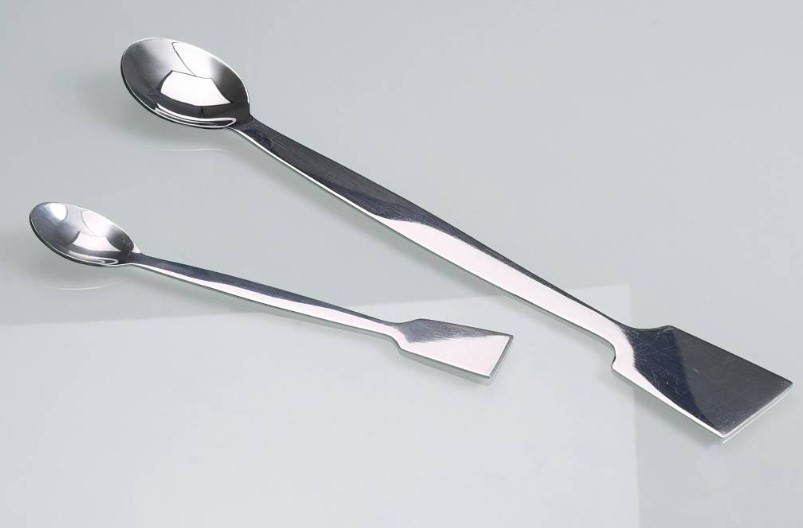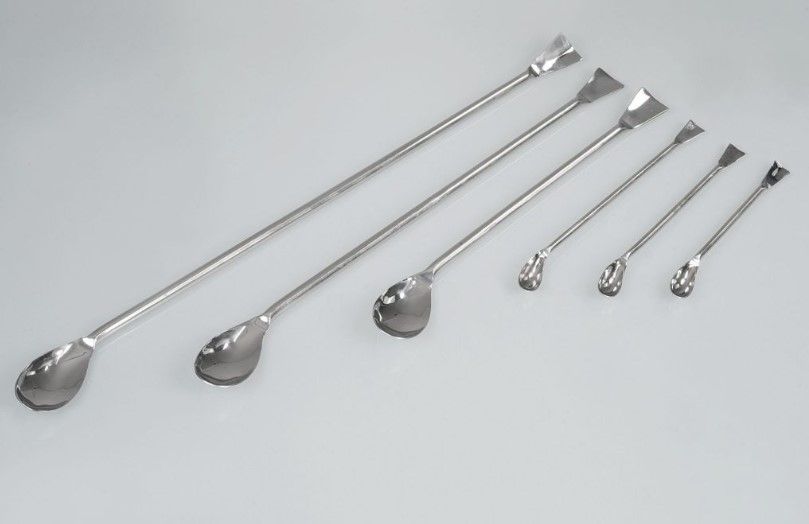The laboratory spatula is used for measuring solids, moving objects and for scraping material from beakers. Spatulas can also be used for other purposes, including non-slip covers and weights.
📌 What is a laboratory spatula?
In laboratories, the spatulas and micro spatulas are small stainless steel utensils, used to scrape, transfer or apply powders and pastes as products chemicals or treatments.
Many brands of spatulas are also resistant to acids, bases, heat and solvents, making them ideal for use with a wide range of compounds.


🔬 Types of laboratory spatula
The spatulas used in laboratories are not of the same type as those found in the everyday kitchens.
These spatulas are usually metal with a smaller spatula as the end and the other end is more tapered to access smaller areas.
You may seem spatulas that have a wooden handle and a wider piece of metal as well.
There are also micro spatulas used in the laboratory.
These are very similar to the normal spatulas but smaller, as the name suggests. Team it can also be used to stir and mix compounds in containers
small.
Steel spatulas stainless and nickel are particularly versatile, especially when they are coated with polypropylene, and are characterized by their excellent resistance to heat and chemicals. Laboratory spatulas they can be sterile, non-sterile or single-use.
Spatulas are also they are used to transport and distribute dry chemical compounds during chemical analysis.
They are used when weighing chemicals on a scale because they allow users to pick up extremely small quantities.


🔍 Versatility of laboratory spatulas
Many brands of spatulas are also resistant to acids, bases, heat and solvents, making them ideal for use with a wide range of make.
A common type would be stainless steel spatulas, which are they are widely used because they are durable and affordable.
They are resistant to spoilage due to contact with boiling water, acids, bases and most solvents. Some of them come with a handle of polyvinyl chloride plastic or riveted hardwood for better handling.
Polystyrene spatulas are made for researchers because they are disposable, which prevents any potential contamination from occurring often with reusable spatulas. They are also ideal for handling lyophilized products or to perform lyophilizations.
🍀 Laboratory micro spatula
A micro spatula, which it is a portable device, it is used in chemical laboratories to flip, trimming and spreading substances during chemical analyses.
A typical primary sheet measures 30 x 60 millimeters. The other end has a blade with the same dimensions, but with a slight upward inclination. The average length of a spatula tool is 7 inches.
🔹 Maintenance of stainless steel spatulas
Stainless steels they need to be cleaned for aesthetic considerations and to preserve the corrosion resistance.
Any contamination of the surface by dirt or other material prevents the natural process of passivation and traps the corrosive agents, thus reducing the protection against the rust.
Some form of cleaning routine is necessary to preserve the appearance and integrity of the surface and really thrive with frequent cleaning. Unlike other materials, it is impossible to "wear out" stainless steel with excessive cleaning.
Like any surface that is used can get dirty, which can consist of accumulated dust and a variety of contaminants that come from many sources in the laboratory.
These pollutants vary greatly in their effect on the appearance and effects of corrosion.
While some they can be easily removed, others may require specific cleaners for effective removal and it may be necessary to identify the contaminant or experiment with various cleaners.
Warm water with or without a mild detergent is often enough. The next step is non-scratching soft abrasive powders and general-purpose cleaning solutions. These can be used with warm water, bristle brushes, sponges or clean cloths.
⭐ Types of cleaners and methods
Clean water and wipes is the simpler method and stainless steel surfaces thrive with a frequent cleaning. A soft cloth and clean warm water should always be the first choice for soft stains and dirt and loose floors.
A final rinse with clean water and a dry rag will complete the process and eliminate the possibility of stains from water.
Ultrasonic water baths Clifton can be useful for a cleaning process, using the activity ultrasonic, in a water-based detergent solution that removes residues and the dirt.
A final rinse with clean water and a dry rag will complete the process and eliminate the possibility of stains from water.
Solvent cleaning with organic solvents can be used to remove fresh residues, oils, chemicals that have not had time to oxidize or break. The preferred solvent is one that does not contain chlorine, such as acetone, methyl alcohol and mineral spirits.
There are many organic compound or blended cleaners that are commercially available. Cleaning can be carried out by immersing the smaller items directly in the solvent, wiping them with solvent-impregnated cloths or using steam or spray methods.
Commercial cleaners
Many commercial cleaners phosphate compounds, synthetic detergents and alkalis are available for the cleaning of heavily soiled or stained stainless steel surfaces.
When used with a variety of cleaning methods, these cleaners can provide a effective cleaning in a safe way.
A neutral low chloride cleaner is preferred and should be rinsed thoroughly after cleaning. The fact that the label says "for stainless steel" does not guarantee that the product is suitable.

